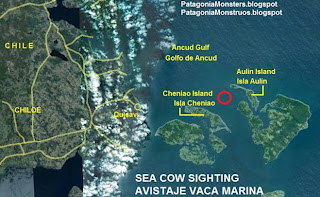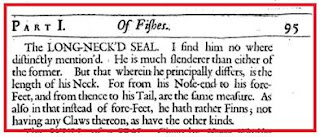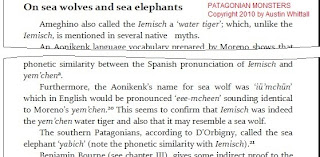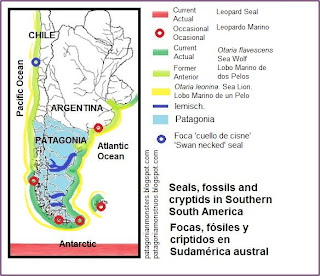Huemul Island fusion complex. Copyright © 2010 by Austin Whittall
On the web I have read that Nahuelito may be a mutation produced by radioactivity caused by “nuclear experiments that were done on Huemul Island during the 50’s”. [11]
In today’s post we will look into this assertion and see if it is true or just another wild theory.
Argentina after World War II
Argentina’s military dictators (who ran the country from 1943 until 1946) were, to put it mildly, pro-Nazis and fascists.[12] They were of extreme rightist ideology, and as such, they resisted taking sides during World War II, adopting a neutral position which bordered on supporting the Nazi regime. Only when it was completely clear that the Nazi’s were going to lose the war, did the Argentine government severe its diplomatic ties with the Axis powers (Jan. 1944) and shortly after declare war on them on March 23, 1945.
For those who may not be aware of these facts former President Juan Perón was a Colonel in the Army during this period. He later became president (after winning the general elections in 1946) and after changing the constitution to allow his reelection, was chosen president again in 1952. He then gave his government a dictatorial tint (jailing those who opposed him, censoring the news, etc.). He was ousted by a military coup in 1955. He was also pro-Nazi.
The army had sent him in 1938, on a tour of duty to Spain, Germany and Italy. During his training there, he became convinced that the Axis would win the war and that Mussolini’s fascist dictatorship in Italy was a model to follow in Argentina, and which he did impose during his second term as president.
After Germany surrender, he allowed refugees from Germany to settle in Argentina, and, it is said, embraced escaped Nazi leaders.[13] It is a shameful stain for Argentina’s honor that this happened, and that the "Peronist" regime allowed war criminals to find a safe haven in our country (i.e Adolf Eichmann, Josef Mengele, Erich Priebke, and others).
The former Nazi scientists
In this context, the Argentine government, seeking to position Argentina among the leading countries of the world, also enticed scientists from the defeated Germany to settle in the country.
With their help, Argentina would manufacture and fly the first Jet fighter plane in Latin America (1947) which was perfected (Pulqui II) by famous German aircraft designer Kurt Tank. Unfortunately Argentina’s economic woes killed the project by the early 60’s.
But not only was Peron looking for military technology, he was interested in nuclear energy, not for weapon production but as a source for cheap energy to develop Argentina's steel and aluminum industries.
Richter the bogus nuclear man
Ronald Richter (1909-1991) was a German [3] (actually born in Falkenau which then was part of Austria and now is part of the Czech Republic) refugee, a physical chemist who claimed to have a degree from the University of Prague.
After Argentine authorities contacted Professor Kurt Tank they invited Dr. Richter to work on a nuclear fission reactor. Dr. Richter signed a contract with the Argentine government in October 1948, and in June 1949, he began building his laboratory on Huemul Island.
He chose the place because Lake Nahuel Huapi offered plenty of clean water, and the place lacked dust which could wreak havoc with the delicate instruments needed in the plant. Furthermore, being an island, it was a safe spot to keep spies away.
Richter was not interested in conventional nuclear fission (as in Atomic bombs or current nuclear reactors that generate electricity all around the world) but in fusion using a technology that he had pioneered in Nazi Germany in 1942.
Fusion, unlike fission, is what powers the stars and the sun, it is the energy inside Hydrogen bombs. It releases enormous amounts of energy when two “light” atoms “fuse” into one. (Fission, the stuff of A-bombs on the other hand, is the energy released by splitting large unstable Uranium or Plutonium atoms).
Until today nobody has managed to design or power up a self sustaining fusion reactor that releases more energy than it uses. It is clear that Peron and Richter were aiming high.
He worked hard and soon, in February 1951, claimed that at his Huemul Island reactor he had “
succeeded in sustaining a controlled fusion reaction using his shock wave technology”. [1]
Peron immediately saw the political advantages and quickly (prematurely) announced these surprising and ground breaking results to the world on March 24.[9]
Peron had bought from Richter the idea of cheap energy generated by fusion reaction as a way to promote industrialization and help forge a “New Argentina”. [2] He even went as far as announcing that he would sell atomic energy in liter and half-liter bottles for family and industrial use [3]:
very soon we will have a surplus of energy with [the technology that] we are developing at Huemul . We will sell it in bottles of one and half liters [1 and half pints respectively] for industrial and family use, which can be used to provide light, cook food and heat irons [10]
Incidentally, this announcement drove the US to begin its own fusion program. [2] Which still has to produce a self sustaining fusion reactor.
Trials continued and in December, Richter suggested to Peron that some kind of joint venture with the U.S. would quicken the development of this technology.[4]
But then something happened and in March 1952 Richter said that his work was being sabotaged. A commission was sent to investigate in September 1952, which issued a report “
Informe del Dr. Jose Antonio Balseiro referente a la inspection realizada en la isla Huemul en setiembre de 1952" , which concluded with the following phrase:
Based on the above mentioned proof and comments, the undersigned considers himself authorized to assert that there is no serious scientific basis in Dr. Richter’s claim that he had attained a controlled thermonuclear reaction, deeply regretting having had to reach this conclusion.
Buenos Aires, September 16, 1952
This marked Richter’s fall.
By November of that year, Richter was sacked and all 300 workers in the fusion pilot plant dismissed. [5] In September 1954 he was denounced at Congress because of the non replicability of his tests. He was held in jail in Congress for a few days.
He would later leave the country, but he returned and died here in 1991.
Dr. Balseiro, who had issued the condemning report would later head the Argentine National Commission on Atomic Energy (CNEA), which successfully developed and built fission reactors for peaceful purposes, one of which was located at the “Centro Atomico Bariloche”, right in front of Huemul Island, on the mainland (see map above).
Huemul island became a familiar pun to the Argentines who came up with the anagram: “Huele a mula” which, in can be roughly translated as “it is a rip-off”, "someone is cheating". [3]
Radioactivity?
Richter’s fusion plant did not involve uranium or fissionable radioactive material, he merely created hot plasma gas using hydrogen and lithium. Non-radioactive products. So we can not trace any radioactivity to his activities on the island.
The island with its facilities remained in the hands of the CNEA, but lack of maintenance and active destruction by the Argentine Army in 1978 (during a border conflict with Chile, the army used the buildings for military games and shelled the place). [14]
The CNEA handed it over to the government of Río Negro province, which in turn ceded it to the Municipality of San Carlos de Bariloche, which declared it a “Historical, Ecological and Touristic Municipal Reserve” and now (Oct. 2010) is inviting companies to bid in an international tender to manage the Reserve as a tourist attraction.
But lets go back to radioactivity.
After the Huemul fiasco, the CNEA undertook serious research and after finding large uranium reserves in Mendoza province (1951) it purchased a synchrocyclotron (1952), opened the “Balseiro Institute”in Bariloche (1955) and manufactured its first fission reactor (1958), located in Buenos Aires. [8]
At Bariloche there is one low power nuclear reactor, the “Reactor Argentino RA-6”, which began operating in 1982. It is located at the Centro Atomico Bariloche and is used not only for teaching purposes (at the Balseiro Institute), but also for cancer treatment. It is a multipurpose reactor with an output of 500 KW, using enriched uranium (20%) and Uraniuim 235 (80%). [15]
Though it was built on a fault (see my post on “
Nahuelito gas and bubbles"), the risk of a nuclear accident is extremely low. And “
there is no evidence that it has produced radioactive contamination since it began operating”.[9]
It is supervised and audited by the ARN (Nuclear Regulatory Authority) on a yearly basis and samples are taken from the soil and water in the surrounding areas to check for radioactive contamination. So far none has been detected.[16]
Huemul Island
The island itself, has a surface area of 75 hectares (188 acres) of which only 10% will be used for touristic purposes. [7] The remaining part of the island is covered by forests. It is located just off the coast between Playa Bonita and Puerto Moreno. In the map above you can see how close it is to the current Centro Atomico Bariloche facilities.
Read more about its real name
(not HueMul but HueNul).
Conclusions
Richter’s fusion plant did not release radioactivity in the early 50’s.
Current fission reactor has not released radioactivity (1982-2010).
There is no possibility that any local animals could have received radioactive dosage from the CNEAs activities in the area and mutated into lake monsters.
The “mutation due to radioactivity” theory can be dismissed.
Bibliography
[1] Henry Stevens, (2007).
Hitler's Suppressed and Still-Secret Weapons, Science and Technology Adventures Unlimited Press, pp. 263.
[2] Leslie Bethell, (1984).
The Cambridge history of Latin America. Cambridge University Press. Vol. 6. pp. 502.
[3] Ronald C. Newton, (1992).
The "Nazi menace" in Argentina, 1931-1947. Stanford University Press, pp. 379.
[4] New York Times.
Argentine Plans Atomic Exchange; Richter, Research Chief, Tells of Negotiations With 'Highly Industrialized' Country. 11.12.1951.
[5] Edward A. Morrows, (1952).
Peron's Atom Dream Fades; Director Reported Arrested; Argentine Dream on Atom Explodes. 05.12.1952,
[6]
Informe del Dr. José Antonio Balseiro referente a la inspección realizada en la isla Huemul en Setiembre de 1952. Instituto Balseiro.
[7]
Breve Historia del Proyecto Isla Huemul. Bariloche Municipality.
[8] CNEA.
Website
[9] ParksWatch,
Parque Nacional Nahuel Huapi, Amenazas.
[9] La Segunda Tiranía.
Comisión 12 Comisión Nacional de Energía Atómica (Capítulo I). Antecedentes para la creación del “Centro Huemul”
[10] Alfonso Crespo, (1978).
Eva Perón, viva o muerta Librerías-Editorial Studium, pp. 286.
[11] Anita González. (2004).
El monstruo del Nahuel Huapi. Extraño y gigantesco animal concita interés de argentinos. Austral. Temuco.
[12] Ricardo M. Setaro, (1944).
Argentina, fascist headquartersAutores. Council for Pan American democracy.
[13] Uki GoñI, (2002).
The real Odessa: smuggling the Nazis to Per&oacutEe;n's Argentina Editor Granta.
[14] Ernesto R. Ríos, (2007).
Planta Piloto Huemul: se cumplen 56 años … 26.03.2007
[15] INVAP.
Reactores RA-6 y RA-8 de Argentina.
[16] Autoridad Regulatoria Nuclear, ARN.
Report.
Patagonian Monsters -
Cryptozoology, Myths & legends in Patagonia2010 International Year of Biodiversity Copyright 2009-2010 by Austin Whittall ©
































